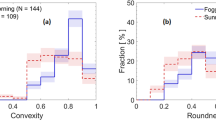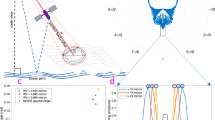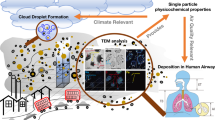Abstract
OF the many methods proposed hitherto for the measurement of the size and concentration of droplets in fogs and clouds, none can be considered as quite satisfactory. The extensively used method of diffraction rings (corona) can be applied only in the relatively rare case of isodisperse fogs. The photographic method devised by Findeisen1 is rather complicated, and can scarcely be used in field work. The direct measurement of the droplets collected on greased wires or on glass slides is hampered by very rapid evaporation of the droplets and distortion of their spherical shape. The method proposed recently by Hagemann2, namely, collecting the droplets on a thin layer of castor oil and photographing them during their fall through the layer, has many disadvantages and can be used only for droplets with a radius less than 5.
This is a preview of subscription content, access via your institution
Access options
Subscribe to this journal
Receive 51 print issues and online access
$199.00 per year
only $3.90 per issue
Buy this article
- Purchase on Springer Link
- Instant access to full article PDF
Prices may be subject to local taxes which are calculated during checkout
Similar content being viewed by others
References
Findeisen, Gerlands Beiträge, 35, 295 (1932).
Hagemann, Gerlands Beiträge, 46, 261 (1936).
Author information
Authors and Affiliations
Rights and permissions
About this article
Cite this article
FUCHS, N., PETRJANOFF, I. Microscopic Examination of Fog-, Cloud-and Rain-Droplets. Nature 139, 111–112 (1937). https://doi.org/10.1038/139111b0
Issue Date:
DOI: https://doi.org/10.1038/139111b0
This article is cited by
-
Virus survival as a seasonal factor in influenza and poliomyelitis
Antonie van Leeuwenhoek (1962)
Comments
By submitting a comment you agree to abide by our Terms and Community Guidelines. If you find something abusive or that does not comply with our terms or guidelines please flag it as inappropriate.



